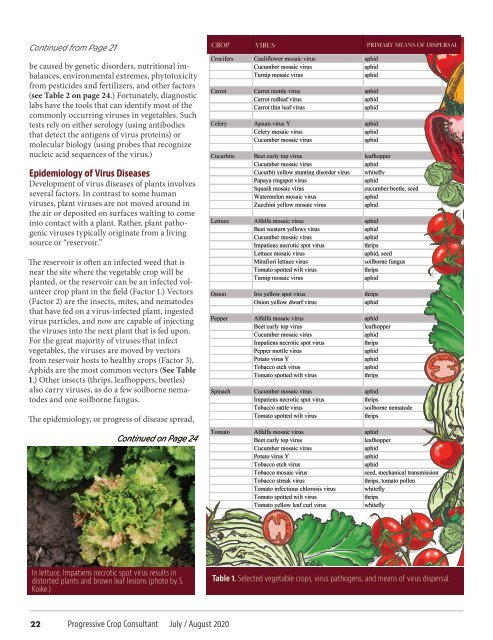You also want an ePaper? Increase the reach of your titles
YUMPU automatically turns print PDFs into web optimized ePapers that Google loves.
Continued from Page 21<br />
be caused by genetic disorders, nutritional imbalances,<br />
environmental extremes, phytotoxicity<br />
from pesticides and fertilizers, and other factors<br />
(see Table 2 on page 24.) Fortunately, diagnostic<br />
labs have the tools that can identify most of the<br />
commonly occurring viruses in vegetables. Such<br />
tests rely on either serology (using antibodies<br />
that detect the antigens of virus proteins) or<br />
molecular biology (using probes that recognize<br />
nucleic acid sequences of the virus.)<br />
Epidemiology of Virus Diseases<br />
Development of virus diseases of plants involves<br />
several factors. In contrast to some human<br />
viruses, plant viruses are not moved around in<br />
the air or deposited on surfaces waiting to come<br />
into contact with a plant. Rather, plant pathogenic<br />
viruses typically originate from a living<br />
source or “reservoir.”<br />
The reservoir is often an infected weed that is<br />
near the site where the vegetable crop will be<br />
planted, or the reservoir can be an infected volunteer<br />
crop plant in the field (Factor 1.) Vectors<br />
(Factor 2) are the insects, mites, and nematodes<br />
that have fed on a virus-infected plant, ingested<br />
virus particles, and now are capable of injecting<br />
the viruses into the next plant that is fed upon.<br />
For the great majority of viruses that infect<br />
vegetables, the viruses are moved by vectors<br />
from reservoir hosts to healthy crops (Factor 3).<br />
Aphids are the most common vectors (See Table<br />
1.) Other insects (thrips, leafhoppers, beetles)<br />
also carry viruses, as do a few soilborne nematodes<br />
and one soilborne fungus.<br />
The epidemiology, or progress of disease spread,<br />
Continued on Page 24<br />
CROP VIRUS PRIMARY MEANS OF DISPERSAL<br />
Crucifers Cauliflower mosaic virus aphid<br />
Cucumber mosaic virus<br />
aphid<br />
Turnip mosaic virus<br />
aphid<br />
Carrot Carrot mottle virus aphid<br />
Carrot redleaf virus<br />
aphid<br />
Carrot thin leaf virus<br />
aphid<br />
Celery Apium virus Y aphid<br />
Celery mosaic virus<br />
aphid<br />
Cucumber mosaic virus<br />
aphid<br />
Cucurbits Beet curly top virus leafhopper<br />
Cucumber mosaic virus<br />
aphid<br />
Cucurbit yellow stunting disorder virus whitefly<br />
Papaya ringspot virus<br />
aphid<br />
Squash mosaic virus<br />
cucumber beetle, seed<br />
Watermelon mosaic virus<br />
aphid<br />
Zucchini yellow mosaic virus<br />
aphid<br />
Lettuce Alfalfa mosaic virus aphid<br />
Beet western yellows virus<br />
aphid<br />
Cucumber mosaic virus<br />
aphid<br />
Impatiens necrotic spot virus<br />
thrips<br />
Lettuce mosaic virus<br />
aphid, seed<br />
Mirafiori lettuce virus<br />
soilborne fungus<br />
Tomato spotted wilt virus<br />
thrips<br />
Turnip mosaic virus<br />
aphid<br />
Onion Iris yellow spot virus thrips<br />
Onion yellow dwarf virus<br />
aphid<br />
Pepper Alfalfa mosaic virus aphid<br />
Beet curly top virus<br />
leafhopper<br />
Cucumber mosaic virus<br />
aphid<br />
Impatiens necrotic spot virus<br />
thrips<br />
Pepper mottle virus<br />
aphid<br />
Potato virus Y<br />
aphid<br />
Tobacco etch virus<br />
aphid<br />
Tomato spotted wilt virus<br />
thrips<br />
Spinach Cucumber mosaic virus aphid<br />
Impatiens necrotic spot virus<br />
thrips<br />
Tobacco rattle virus<br />
soilborne nematode<br />
Tomato spotted wilt virus<br />
thrips<br />
Tomato Alfalfa mosaic virus aphid<br />
Beet curly top virus<br />
leafhopper<br />
Cucumber mosaic virus<br />
aphid<br />
Potato virus Y<br />
aphid<br />
Tobacco etch virus<br />
aphid<br />
Tobacco mosaic virus<br />
seed, mechanical transmission<br />
Tobacco streak virus<br />
thrips, tomato pollen<br />
Tomato infectious chlorosis virus whitefly<br />
Tomato spotted wilt virus<br />
thrips<br />
Tomato yellow leaf curl virus<br />
whitefly<br />
In lettuce, Impatiens necrotic spot virus results in<br />
distorted plants and brown leaf lesions (photo by S.<br />
Koike.)<br />
Table 1. Selected vegetable crops, virus pathogens, and means of virus dispersal.<br />
22 Progressive Crop Consultant <strong>July</strong> / <strong>August</strong> <strong>2020</strong>


















